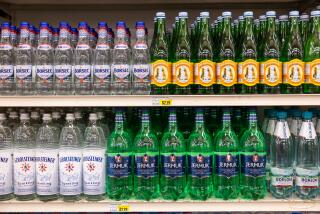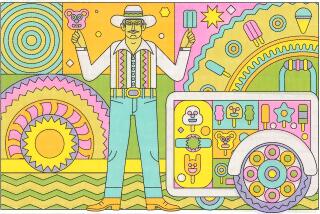2 Tiny Seltzer Firms Are Making a Splash : Profit From Bottled Water Craze, Marketing in Old Spritz Containers
- Share via
For years the seltzer business was kind of, well, flat. The old customers were dying, and the companies themselves seemed moribund.
But that was before aerobics, Perrier and wine coolers. Sparkling water of every kind is “in” nowadays, and seltzer is enjoying a resurgence that big companies, such as Canada Dry and Schweppes, hope to exploit.
So do Julian Diamond and Morton Shechtman. Julie and Mort, as they are known, are the last remaining providers of old-fashioned, home-delivered, spritz-bottle seltzer in Southern California.
They do business a short hop from one another deep in the heart of industrial North Hollywood. Although the two companies monopolize the business locally, antitrust enforcers needn’t worry about collusion. Julie and Mort nurse a healthy dislike for one another--and maintain an even healthier competition.
Diamond, 59, whose family started A-1 Seltzer in the 1920s or 1930s--he isn’t sure of an exact date--runs the company out of a kind of industrial barn filled with bottles and equipment that wouldn’t look out of place in the Smithsonian.
Shechtman, 40, a relative novice with just 24 years in seltzer, used to own an A-1 delivery route until he and Diamond had a falling-out in 1976. Now, he and his father, Sidney, have their own little plant, Fremor Seltzer, jammed with their own antique bottles and ancient equipment.
Both business owners hope to benefit from America’s current love affair with light-colored, low-calorie, salt-free and caffeine-free beverages, of which seltzer is probably the most extreme example this side of tap water. Authentic seltzer is just purified water that has been carbonated.
Neither Julie’s company nor Mort’s will have an easy time exploiting the trend.
For one thing, the big beverage companies are not about to leave the booming seltzer business to Julie and Mort. The beverage giants already have put bottles of plain and flavored seltzer in supermarkets, and Canada Dry is claiming to be the No. 1 seltzer seller with 41% of the market.
But A-1 and Fremor also have each other to contend with. Both claim more volume and better seltzer than the other, and each is planning to expand. A-1 wants to branch out into San Diego, while Fremor hopes to add a cash-and-carry business to its home delivery service.
Then there is the problem of product image. Like their locations in the flats of the San Fernando Valley, A-1 and Fremor are not exactly perceived as the height of fashion.
“Those people in their spas in Encino and Tarzana, they’re not going to drink seltzer,” Shechtman worries. “They’re going to use Perrier.”
Firms Are Thriving
Nevertheless, both men say their firms are thriving, partly because their delivery people will drive extraordinary distances to serve established customers and partly because their old-fashioned products “are in keeping with modern life styles,” in the words of Gary Hemphill, editor of Beverage Industry, a trade magazine.
No one knows exactly how much seltzer Americans drink, but industry analysts estimate that supermarkets and grocery stores alone sold 26 million gallons last year, a small share of the 10.6 billion gallons of soft drinks consumed nationwide in 1985.
And all agree that seltzer consumption is on the upswing. Albert Armitage, marketing vice president for Schweppes, said sales are growing 20% a year versus just 4% for soft drinks overall.
“It’s a very good business,” said Diamond, a former bantamweight boxer. “Everybody is very health conscious.”
Unlike most club soda and mineral waters, seltzer is salt-free. Seltzer makers claim that it is purer than tap water and has more bounce than spring water. Diamond and Shechtman contend that their stuff is even better than store-bought seltzer.
Both say their product is bubblier and stays that way because the siphon top retains carbonation down to the last drop. Their prices are reasonably competitive with those of retailers. Charges vary with distance, and sometimes by driver, but Fremor generally charges $4, and A-1, $4.50 a case.
But A-1 and Fremor don’t just offer fizz. They offer nostalgia.
Use Old Bottles
Besides the familiar clank of home delivery and the powerful spray of ancient metal valves, the two companies sell their products in tens of thousands of evocative old bottles purchased from defunct seltzer companies all over the country.
The bottles, some dating to the turn of the century, weigh three or four pounds each and bear the names of long-departed seltzer companies from Cincinnati to San Francisco. Some have Art Deco designs, and most carry chrome-plated pewter siphons that can knock a glass right out of your hand with a jolting burst of sparkling water. They squirt so hard that seltzer bottles used to be sold as fire extinguishers, and Diamond still has one labeled that way.
Diamond and Shechtman say such bottles aren’t made anymore in an age of plastics and disposables, and, although some occasionally break, the heavy glass is extraordinarily tough. A few bottles are too precious to risk in the hands of customers. Diamond maintains a private collection of about 200, some of which are worth up to $1,000 each, he said.
Recognizing the potential for cachet, Shechtman has decided to stop using plastic replacement valves when metal siphons fail and to start making his own. The plastic works fine, but it lacks panache, he says.
Those whose vision of a modern bottling facility runs to dexterous machines filling armies of bottles like robots had better not visit A-1 or Fremor.
80-Year-Old Machine
Humans and disarray are both much in evidence. At A-1, the seltzer is bottled at an average rate of 15 bottles a minute, which is as fast as the guy filling them can work.
Bottling takes just 90 minutes a day on a machine that looks like an Industrial Revolution relic. It actually dates back a mere 80 years.
Fremor’s machine is identical, and both companies use tap water, which they purify. It is pumped into the bottle while the machine holds the siphon valve open. Shechtman said the carbonation is dissolved at a pressure of 130 pounds per square inch.
Both businesses are family affairs. Fremor has only one worker, a part-timer, who is not a Shechtman. Diamond, meanwhile, has run A-1 for 36 years.
“I even sweep up,” he says. The company was founded by his great uncle, David Liberman, who brought the business over from England.
Fremor (named after Mort and his sister Freida) is run by Mort and his 75-year-old father, who still hauls cases.
The seltzer business is not all effervescence, and Diamond and Shechtman must cope with some up-to-date problems. Gasoline is a big cost, so the drop in oil prices helps. On the other hand, the rising price of liability insurance hurts.
Insurance Expensive
Shechtman says the $9,000 a year that he now pays for coverage is his single biggest expense, surpassing labor, water and liquid carbon dioxide. Seltzer doesn’t seem particularly dangerous, outside of Marx Brothers movies, but the bottles are pressurized and lawsuits can be devastating.
Neither A-1 nor Fremor discloses many financial details. Each claims annual revenue of about $100,000, but A-1, which fills about 1,200 bottles a day versus 780 for Fremor, appears to sell more seltzer. A-1’s gross includes sales to four independent drivers who have their own trucks. Fremor has one independent. Both firms sell syrup and some regular soda as well.
A-1 used to be on East Washington Boulevard in Los Angeles, but in 1980 it bought out Valley Seltzer, the only other company in the business in Southern California besides Fremor. The move heightened the ill will between Diamond and Shechtman.
Shechtman sees himself in a role similar to that of Pennzoil, which claims that Texaco wrongfully interfered with Pennzoil’s agreement to buy Getty Oil. Shechtman claims that he gave the owners of Valley Seltzer a deposit to buy the business but that they instead made a deal with A-1 and returned his check uncashed. Max Locker, a former part-owner of Valley Seltzer, denied the assertion, and A-1 says only that its deal was legitimate.
But bad feelings predate that incident. Shechtman complains that Diamond wouldn’t sell him gasoline for his truck when gas was in short supply in the early 1970s and that A-1 started raising the price of seltzer.
“Everything goes up,” retorts Diamond, who says Shechtman has only told half of the story but who nevertheless won’t tell the rest himself. He only says: “It’s not the best relationship.”
Ethnic Preferences
Until now, selling seltzer required keeping old customers and understanding ethnic preferences. Jews are big customers, for example, especially around Passover in the spring. Argentines are big seltzer lovers too, as are Hungarians, who like it with raspberry syrup.
Shechtman says he advertises in Hungarian newspapers, phone books and anything else Hungarian that he can get his hands on.
Yet the business can’t remain the same, Shechtman says. He foresees change and plans to market his seltzer more aggressively to boost sales and entice a new generation of customers. As a first step, he said, he’ll put his name and phone number on the shoulders of his bottles, without obscuring their nice old designs, and he’ll mount big signs on the two trucks that he and his father drive.
He’s already bought more than 60,000 bottles (three times his competitors’ supply), and he is adding two more trucks with hired drivers. While seltzer can provide a nice living, that’s not the main reason he hopes his children will follow him into the business, he said.
“It’s just neat,” he said. “All kidding aside, it’s just neat.”
More to Read
Inside the business of entertainment
The Wide Shot brings you news, analysis and insights on everything from streaming wars to production — and what it all means for the future.
You may occasionally receive promotional content from the Los Angeles Times.










